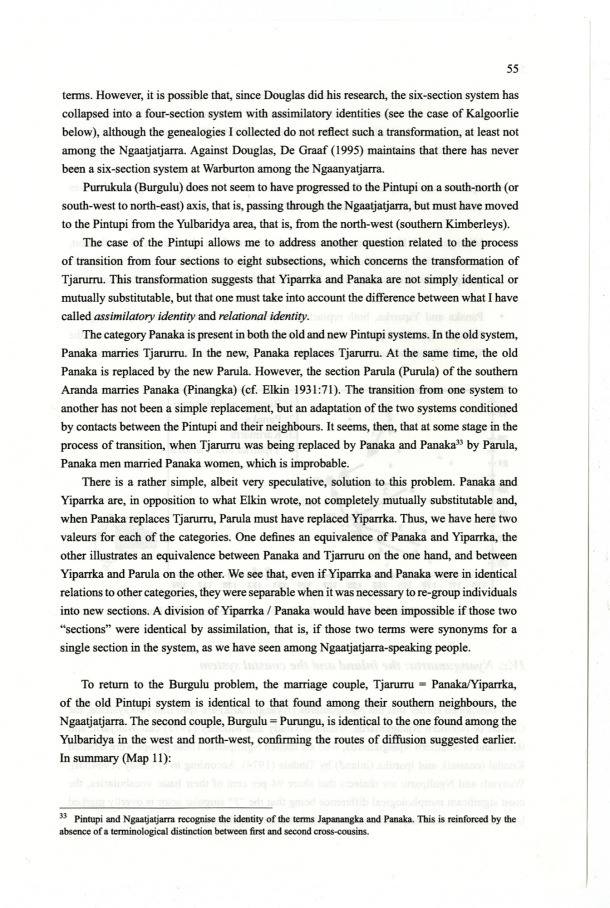|
| 
[Note: this transcription was produced by an automatic OCR engine]
55
terms. However, it is possible that, since Douglas did his research, the six-section system has
collapsed into a four-section system with assimilatory identities see the case of Kalgoorlie
below, although the genealogies I collected do not reflect such a transformation, at least not
among the Ngaatjatjarra. Against Douglas, De Graaf 1995 maintains that there has never
been a six—section system at Warburton among the Ngaanyatjarra.
Purrukula Burgulu does not seem to have progressed to the Pintupi on a south-north or
south-west to north-east axis, that is, passing through the Ngaatjatjarra, but must have moved
to the Pintupi from the Yulbaridya area, that is, from the north-west southern Kimberleys.
The case of the Pintupi allows me to address another question related to the process
of transition from four sections to eight subsections, which concerns the transformation of
Tjarurru. This transformation suggests that Yiparrka and Panaka are not simply identical or
mutually substitutable, but that one must take into account the difference between what I have
called assimilatory identity and relational identity.
The category Panaka is present in both the old and new Pintupi systems. In the old system,
Panaka marries Tjarurru. In the new, Panaka replaces Tjarurru. At the same time, the old
Panaka is replaced by the new Parula. However, the section Parula Punila of the southern
Aranda marries Panaka Pinangka cf. Elkin 1931:7l. The transition from one system to
another has not been a simple replacement, but an adaptation of the two systems conditioned
by contacts between the Pintupi and their neighbours. It seems, then, that at some stage in the
process of transition, when Tjarurru was being replaced by Panaka and Panaka” by Parula,
Panaka men married Panaka women, which is improbable.
There is a rather simple, albeit very speculative, solution to this problem. Panaka and
Yiparrka are, in opposition to what Elkin wrote, not completely mutually substitutable and,
when Panaka replaces Tjarurru, Parula must have replaced Yiparrka. Thus, we have here two
valeurs for each of the categories. One defines an equivalence of Panaka and Yiparrka, the
other illustrates an equivalence between Panalra and Tjarruru on the one hand, and between
Yiparrka and Parula on the other. We see that, even if Yiparrka and Panaka were in identical
relations to other categories, they were separable when it was necessary to re—group individuals
into new sections. A division of Yiparrka / Panaka would have been impossible if those two
“sections” were identical by assimilation, that is, if those two terms were synonyms for a
single section in the system, as we have seen among Ngaarjatjarra-speaking people.
To return to the Burgulu problem, the marriage couple, Tjarurru = Panaka./Yiparrka,
of the old Pintupi system is identical to that found among their southern neighbours, the
Ngaatjatjarra. The second couple, Burgulu = Purungu, is identical to the one found among the
Yulbaridya in the west and north-west, confirming the routes of diffusion suggested earlier.
In summary Map 11:
33 Pintupi and Ngaatjatjarra recognise the identity of the terms Japanangka and Panaka. This is reinforced by the
absence of a terminological distinction baween first and second cross-oousins.
|